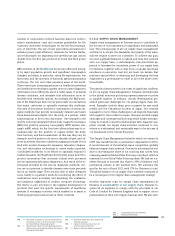Siemens 2011 Annual Report Download - page 170
Download and view the complete annual report
Please find page 170 of the 2011 Siemens annual report below. You can navigate through the pages in the report by either clicking on the pages listed below, or by using the keyword search tool below to find specific information within the annual report.
6 A. To our shareholders
23 B. Corporate Governance 51 C. Combined management’s discussion and analysis
52 C. Business and operating environment
80 C.2 Fiscal – Financial summary
83 C. Results of operations
101 C. Financial position
114 C. Net assets position
117 C. Overall assessment of the economic position
118 C. Report on post-balance sheet date events
119 C. Report on expected developments and
associated material opportunities and risks
135 C. Information required pursuant to Section ()
and Section () of the German Commercial
Code (HGB) and explanatory report
To date, there is no applicable international standard that ap-
plies across companies for qualifying products, systems, solu-
tions and services for environmental and climate protection,
or for compiling and calculating the respective revenues and
the quantity of reduced carbon dioxide emissions attributable
to such products, systems, solutions and services. According-
ly, revenues from our Environmental Portfolio and the reduc-
tion of our customers’ annual carbon dioxide emissions may
not be comparable with similar information reported by other
companies. Furthermore, we subject revenues from our Envi-
ronmental Portfolio and the reduction of our customers’ annu-
al carbon dioxide emissions to internal documentation and re-
view requirements which are less sophisticated than those
applicable to our financial information. We may change our
policies for recognizing revenues from our Environmental
Portfolio and the reduction of our customers’ annual carbon
dioxide emissions in the future without previous notice.
As in previous years, we again commissioned an independent
accounting firm with a limited assurance engagement to re-
view the reported results for our Environmental Portfolio for
fiscal . This review was conducted in accordance with the
International Standard on Assurance Engagements (ISAE)
, Assurance Engagements Other than Audits or Reviews
of Historical Financial Information. Nothing came to the inde-
pendent accounting firm’s attention that would cause them to
believe that the section “Siemens Environmental Portfolio
” of the Environmental Portfolio Report – containing
the revenues generated by the Environmental Portfolio and
the annual customer reduction of carbon dioxide emissions
attributable to it – has not been prepared, in all material re-
spects, in accordance with the defined reporting principles.
Environmental performance
Protecting the environment is a central component of our cor-
porate strategy. By maintaining high environmental manage-
ment standards, we work to overcome environmental chal-
lenges throughout the world.
Environmental management – Our worldwide system of en-
vironmental management is based on our Business Conduct
Guidelines. Specific environmental issues, such as those relat-
ing to hazardous materials, are covered by more detailed reg-
ulations and guidelines. Our environmental management
rules are generally binding for all companies controlled by
Siemens.
A core task of environmental management is tracking our en-
vironmental performance, for example with respect to energy
and resource efficiency. Our monitoring and tracking system
covers all our sites that exceed specific thresholds for re-
source consumption or waste volume. Sites that exceed those
thresholds or have installations requiring authorization or no-
tification also must implement an environmental manage-
ment system (EMS) conforming to the international ISO 14001
standard. Our Divisions are allowed to choose either external
certification of their management systems or internal audits
that meet external certification standards. At the end of fiscal
, locations had verified environmental management
systems in place compared to at the end of fiscal .
Consequently, % of our sites have successfully implement-
ed an EMS by the end of fiscal , compared to % in .
Thus, we have achieved our goal of implementing environ-
mental management systems at all environmentally relevant
sites by the end of fiscal .
Environmental program – Our current environmental pro-
gram was launched in fiscal , using fiscal as the
baseline. Environmental performance is normalized to plant
revenue on a portfolio-adjusted basis. Our targets included
the following: a % reduction in carbon dioxide emissions in-
tensity; a % improvement in energy efficiency, including
separate targets for primary energy and district heat and for
electrical power; a % improvement in water efficiency; and
a % reduction in waste performance. The time frame for all
targets was the end of fiscal . All environmentally rele-
vant manufacturing sites were included in these targets.
Because we normalize our environmental program targets to
revenue, our reported results depend to a significant degree
on factors that influence revenue, such as macroeconomic
conditions and the global market environment for Siemens
businesses. For example, a decline of sales has a significant
influence on our revenue and thus makes it more difficult to
achieve an increase in efficiency in some areas. This was es-
pecially true for electrical energy such as in factories where
we had to decrease output but have little flexibility to reduce
the energy needs of our production systems.
Despite such challenges, our performance in fiscal ex-
ceeded three of our targets and we nearly achieved a fourth.
Our carbon dioxide emissions efficiency was up % com-
pared to the baseline, and energy efficiency for primary
energy and district heat was % better. Our Energy Efficiency
Program (EEP) played an important role in these major im-
























